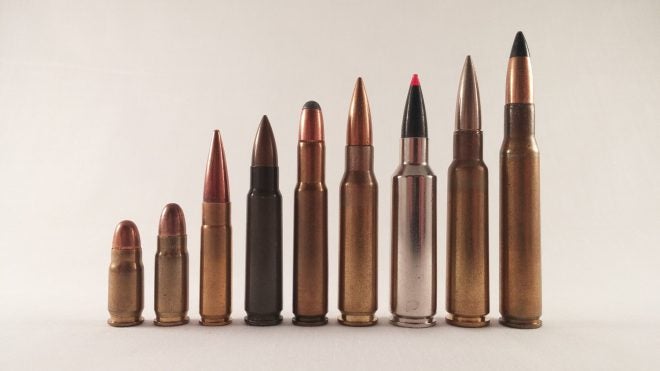“Caliber”. It can mean a lot of different things, but when we use it, what does it really mean, and what’s its significance?
Title image: From left to right are the 7.65 Parabellum, 7.63 Mauser, .300 Blackout, 7.62×45 Czech, .30 Remington, 7.62 NATO, .300 WSM, 7.5×55 Swiss, and .30-06 M2 AP. All of these cartridges are the same caliber (they all use .308 caliber bullets), but paradoxically they are all also different calibers (they aren’t interchangeable with one another).
Today I begin a series of posts on basic ballistics, and the theory behind them, both external (how a bullet flies through the air) and terminal (how a bullet penetrates a target). For the first few installments, we’ll be exploring some very introductory subjects, but hopefully with enough depth that even those readers already familiar will get something out of it, still. As you have already realized, this first episode will deal with the history and usage of the word “caliber”.
caliber
1 : the diameter of a round or cylindrical body
e.g. : What caliber is this cleaning rod?
Caliber is perhaps one of the oldest words in the firearms lexicon. It goes all the way back to the Greek καλαπουσ (kalapous), referring to the hard wooden objects used by shoemakers to mold leather into shoes. At some point, it seems, this term was applied by way of analogy to bullet molds, likely initially with regards to lead sling bullets. As the firearm was developed, this term made its way through Arabic, Tuscan, Middle French, and then Early Modern English, to become the modern day word caliber, which now means many things from “quality” to “measurement”. As a sidenote, the word caliper, referring to a tool used to measure span, seems to be a derivative of the firearms-related word caliber.
caliber
2 : the diameter of a bore of a gun
e.g. : A .50 caliber barrel has a mighty big hole at the end.
With regards to modern firearms, the word “caliber” carries with it a couple of important qualities that today are distinct and can cause confusion, but which stem from a relatively recent change in the fundamental nature of small arms technology. Before the 1850s, almost all firearms were of the muzzle-loading type, and virtually all firearms fired round lead balls. These round balls scaled in weight according to a cube function with their size, given a certain lead alloy used to cast them. This meant that, roughly, a bullet for a firearm that was 0.50″ (12.7mm) in diameter always had the same weight as any other bullet with the same diameter, and the same was true for a bullet 0.70″ (17.8mm), or for any bullet of any other respective diameter. All of these projectiles were, as well, equally compatible with all firearms of the corresponding bore diameter, and – although propellant charges could be adjusted to a certain degree – all firearms with a given bore diameter had the same capabilities in terms of range and terminal performance as any other of that same bore.
caliber
3 : the diameter of a bullet or other projectile
e.g. : I can load .30 caliber bullets in a .308 Winchester case, right?
What this means is that for hundreds of years, from the 12th Century to the mid 19th Century, the word “caliber” at once summed up both the interchangeability of ammunition with a firearm that could fire it, and the capability of that firearm-ammunition combination. A .65 caliber rifle was, at one time, virtually always more capable than a .50 caliber rifle, which was in term more capable than a .45 caliber rifle, and so on, and further each caliber of weapon could use any ammunition of that caliber, as well.
caliber
4 : the type of ammunition compatible with a certain firearm
e.g. : This is a 7.62x54mmR caliber round.
However, in the mid-19th Century, things changed. In the first half of the century, the oblong bullet (incarnated chiefly in the legendary Minié ball projectile) was perfected, disconnecting the weight of the projectile from its caliber. Now, different bullets in the same caliber could have a wide variety of different weights, depending on their exact shape. Soon after, the self-contained metallic cartridge was also invented, which resulted in a more fixed propellant charge for individual ammunition, and further differentiating the capabilities and interchangeability of different weapons and ammunition with the same nominal “caliber” of bore or bullet.
caliber
5 : the type of firearm compatible with a certain kind of ammunition
e.g. : The Mosin Nagant is in 7.62x54mmR caliber.
Further innovations, like smokeless powder, spitzer bullets, and others created an even wider set of possible ammunition paradigms, which continue to expand to this day. This variety has fragmented the meaning of the word “caliber” along with it, resulting in the five different definitions given in this article. As a result, other terms have popped up to differentiate these concepts, such as “bullet diameter” to mean (3), or “chambering” to mean (5), but “caliber” remains an extremely common choice of word for all five meanings.
So “caliber” has gone from meaning the mold used to create a bullet, to a system of nomenclature indicating imprecisely both the capabilities and the interchangeability (or lack thereof) of different kinds of ammunition, and the weapons that fire them. Indeed, now, the word “caliber” more often refers to the name of a given cartridge-rifle system than it does any physical quality of either, for example the .223 Remington caliber is not named after any specific measurement on the bullet (0.224″), case, or bore (0.219″), but simply so-named to differentiate it from other similarly-named calibers!
 Your Privacy Choices
Your Privacy Choices
